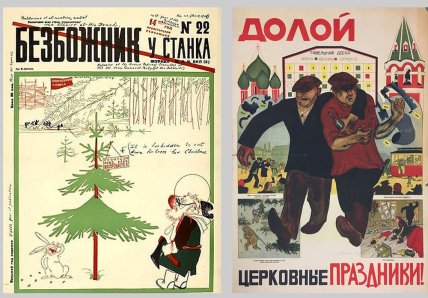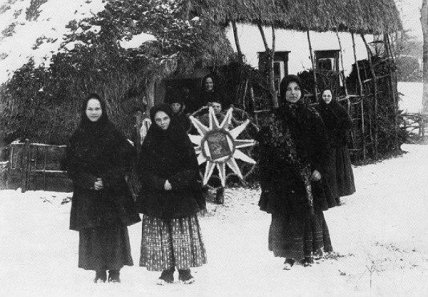How Stalin stole Christmas: a renowned historian discusses the fate of this beloved holiday among Ukrainians.
This year, Ukraine celebrates Christmas on December 25 for the second time. This return has become possible due to the revival of traditions that were erased over decades during the Soviet regime.
Traditional Ukrainian Christmas, with its carols, shchedrivkas, and ritual festivities, fell victim to communist propaganda, which sought to eliminate religious and national elements, replacing them with "new," Soviet ones.
Why did the Kremlin so diligently try to destroy our traditions? How were children used in Soviet propaganda? How did our ancestors secretly celebrate Christmas and other holidays? Why is Santa Claus, who was "invented in Russia," partly a myth, and what does Germany have to do with it?
About this, Telegraph asked renowned historian, publicist, and author of the book "The Big Christmas Book," Yaroslav Hrytsak.
The Struggle Against "Religious Delusion"
The anti-Christmas policy in the USSR began after the October Revolution – in the 1920s.
"Our main task is to assist in the actual liberation of the working masses from religious prejudices," stated the decree of the Council of People's Commissars dated January 23, 1918.
As noted in a conversation with Telegraph by prominent historian Yaroslav Hrytsak, the main reason for the persecutions was not only the suppression of religion. This is perhaps the most vivid example of the fight against Ukrainians themselves, their identity, and future.
– It is very difficult to separate these phenomena at the initial stage. With the Bolsheviks coming to power in 1917, their slogans became the abolition of all "old bourgeois culture." Therefore, not only Christmas was banned, but even New Year, which was not celebrated at that time, – he explains.
According to him, Soviet propaganda attempted to portray any celebrations, children's smiles, and gifts as a "bourgeois relic" that needed to be consciously destroyed.
– In my book "The Big Christmas Book," I wrote about how in the 1920s, mass events were organized to discredit Christmas. For example, rallies were held where even preschoolers participated. They were forced to carry posters with slogans that mocked religious traditions. Thus, propaganda permeated all spheres of life and started literally from the grassroots, – the publicist explains.
 3
3
"Parents, do not confuse us, do not make Christmas and the tree," was written on one of the posters held by the children from kindergarten.
The most vulnerable part of the population was indoctrinated with the idea that the most crimes and drunkenness occur during the winter holidays. By 1927, weekends for religious holidays were completely abolished.
 4
4
As Yaroslav Hrytsak states, such mass attacks were aimed at weakening the influence of the church and traditional culture since they united people. Christmas was the core, the key holiday of every Christian faith.
— Furthermore, Christmas was very popular — it was a holiday of joy, family warmth, and community. In many poor families, it was hardly the only day of the year, when the family could gather around the festive table and enjoy something special. It truly was a nationwide holiday, – the historian believes.
 5
5
The Soviet authorities sought to "tear" this holiday out of people's lives. That is, to deprive it of its folk character and replace it with something new, Soviet. Of course, this also involved the destruction of national identity and historical memory.
"After the Holodomor, villages stopped singing"
There is no documentary evidence of the punishment of those who resisted in the 1920s. However, this is a hypothesis that we must confirm based on people's memories, believes renowned historian Yaroslav Hrytsak.
— In the 1920s, the Soviet authorities did not yet have "teeth and claws", meaning such a developed repressive system that could actively punish. This was a period of relatively moderate policy – the time of NEP (New Economic Policy), – he says.
This means that the authorities were more focused on declarations and ideological struggle. They did not yet have harsh measures or did not want to use them at that time.
— For example, there are interesting memories of Ivan Kozlovsky, a famous Ukrainian singer, who, by the way, was Stalin's favorite singer. He recalled how in the 1920s, as a Red Army soldier, he went caroling with others. This happened, in particular, in Poltava. He also mentioned his meeting with the famous writer Vladimir Korolenko. So I think that by that time, the fight against Christmas had not yet taken on a total character. They could not suppress it, – Yaroslav Hrytsak asserts.
Moreover, , it should be understood that in the 1920s, Ukrainian forces and culture were still strong. The authorities were weak and effectively "hung in the air."
 6
6
The real attack on the tradition began in 1929, during collectivization. At that time, the Soviet authorities introduced large-scale repressive measures that became part of the policy of building a "new country." One of the points of this campaign was the absolute destruction of religion: the closure and destruction of churches, the destruction of paintings in monasteries, the arrest of priests.
— Consequently, attacks on folk traditions intensified. This struggle reached its peak during the Holodomor of 1932-1933. Many who survived the Holodomor recalled that after 1933, villages "stopped singing", and caroling gradually disappeared, – Hrytsak says.
Later on, caroling became simply unsafe. Because caroling was now synonymous with an anti-Soviet act.
"A Generation That Forgot Christmas"
Perhaps the most affected by the anti-religious campaign was one of the most famous Ukrainian carols, "New Joy Has Come."
However, as the historian recounts, the sound of carols could still be heard in Western Ukraine until the 1950s. It was not eradicated so radically, and there are corresponding testimonies. For instance, in Lviv, immediately after the war, in 1945-1946, local students organized a corridor for their professor.
– This happened during a class on Christmas. When the professor, a specialist in Latin, entered the classroom, the students – Poles and Ukrainians – stood up and began to sing. They first caroled in Latin, then in Ukrainian and Polish. And the students from Eastern Ukraine who found themselves in Lviv were surprised, as they had already forgotten what caroling was. This was a vivid example of generational disconnection, – Hrytsak believes.
 7
7
As the historian notes, from the early 1950s, a whole generation of people emerged who did not know what Christmas was. And if they did know, they celebrated it secretly, trying to ensure that no one found out or saw.
"Santa Claus Was Not Entirely Invented by Russians"
Many believe that it was the Russians who invented Santa Claus. However, there are documents that testify otherwise. For example, an advertisement for the celebration of the Christmas tree in the Ukrainian newspaper "Nova Rada" from December 29, 1917, where Santa Claus was already mentioned.
 8
8
There is also a children's fairy tale-play "Santa Claus," written in the 1920s in Volhynia, which then belonged to Poland. Its author, Mykola Shuhayevskyi, had no relation to the USSR and the Bolsheviks — on the contrary, he worked in the Ministry of Education of the UNR.
 9
9
As Yaroslav Hrytsak tells Telegraph, Santa Claus actually appeared in Germany.
– He emerged in the mid-19th century, after the defeat of the 1848 revolution, known as the "Spring of Nations." This revolution was a revolt of the intelligentsia, the middle class, and liberals against the monarchy and the unification of German territories into one nation. After the defeat of the revolution, a German poet, who was a participant, invented the image of Herr Winter — an old man who goes from house to house during Christmas, but no one lets him to the table except for the poor people. Herr Winter became a symbol of Germany, which was "suppressed" but was supposed to rise again, – Yaroslav Hrytsak shares with Telegraph.
 0
0
— This image originated in Germany. It should be understood that most of the attributes of winter holidays, such as Christmas trees and decorations, are also of German heritage. Thus, along